Brian Branciforte, Florida's Wildlife Legacy Initiative Leader
Think big! Bigger. Now double that. In Florida, there is an immense amount of conservation work accomplished and occurring around the state. Federal, local and state governments, academia, nonprofits and non-governmental organizations, tribes, private landowners, businesses and individuals are all contributing. All of this conservation capital adds up to something. But what? How do we as a conservation community clearly articulate, define and measure that something?
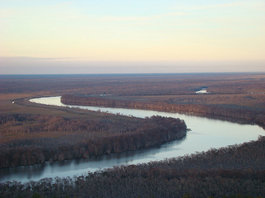
Left: The Box-R Wildlife Management Area, which is located just west of downtown Apalachicola, FWC Photo.
Conservation
is hard. Totaling it is harder. Our community creates strategies, plans and
visions. We talk about corridors, connectivity and landscape scale
conservation. There may or may not be targets, metrics, results chains, outputs
or effectiveness measures, and don’t get me wrong … this is all good. The
conservation community is doing amazing things. But are we as coordinated as we
should be? And are we working toward the same ultimate conservation goal? The
Wildlife Legacy Initiative has tried to answer this rallying call with the Cooperative
Conservation Blueprint, and in many ways spawned the growth of the widely acclaimed
Critical Lands and Waters Identification
Project. It’s time for the next step, and perhaps more dialogue. I think we
can do more and better through working together.
I
challenge you to take a moment to define what conservation success in Florida
looks like to you. Below is a statement that resonates with me:
“A comprehensive network of
conservation
and recreation lands that sustains viable fish
and wildlife
populations, benefits
communities, and enhances Florida’s economy.
This network contributes to the conservation
of biological diversity through large connected natural areas and sustains ecological processes and services. It is managed in collaboration with
a broad network of
actively engaged partners and supportive stakeholders
and results in satisfied users.
The system is recognized, valued, and supported by Florida’s demographically diverse residents and visitors.”
(Adapted
from the Wildlife Management
Area visioning process)
|
Back to top
Kevin Kemp, Wildlife Legacy Biologist
This
past September, a major restoration effort in the headwaters of the Peace
River, one of the largest rivers in southwest Florida, was completed. The Peace
River is a critical component of the area’s ecological landscape and is
therefore identified as a priority freshwater basin in the State Wildlife Action
Plan.
Staff from the Florida Fish and Wildlife Conservation
Commission
teamed up with Polk County Parks and Natural Resources Division,
Southwest Florida Water Management District and the Florida Department of Environmental
Protection
to rehydrate the western portion of Lake Gwyn, which had been drained by the
Wahneta Farms Canal.
The
purpose of this project was twofold. First, the project converted 56 acres of drained lake bottom into
herbaceous marsh, thereby creating much needed fish and wildlife habitat in the
area. Instead of a straight, box-cut
channel that conveyed water quickly, the shallow marsh with deep pools provides an excellent space for wading birds to forage. Many species of reptiles can be
seen basking on the banks of the wetland on warm days, and biologists have also seen otters frequenting the new wetland.
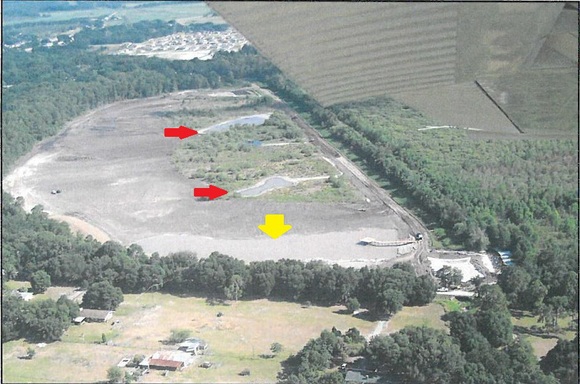
Aerial view of Lake Gwyn while under construction, Photo courtesy of Polk County Parks and Natural Resources Division.
Secondly,
the project was designed to improve the water quality of the Wahneta Farms
Canal before the water enters the Peace River and ultimately the Charlotte
Harbor estuary. In an area verified as impaired for fecal coliforms, the
natural filtration created by the wetland will have beneficial impacts for
miles downstream. The wetland was designed to function during periods of both
high and low water flow, with safety features built in so that no flooding of
upstream neighbors can occur. During high flow events, the water will
sheet-flow across the wetland, while during low flows, the water will flow
through a series of pools (indicated by the
red and yellow arrows in the aerial picture above), continuing to provide
wildlife habitat and water quality benefits.
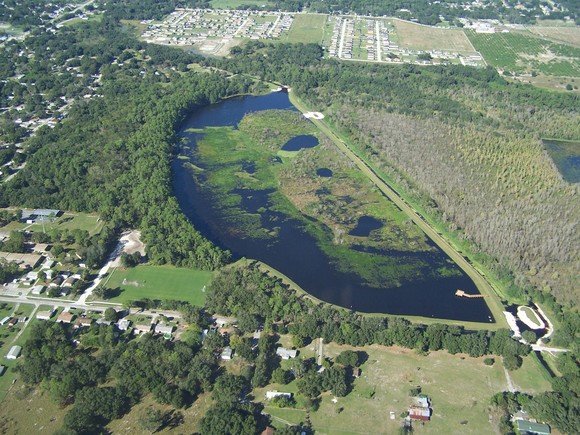
Aerial view of Lake Gwyn after the project was completed, Photo courtesy of Polk County Parks and Natural Resources Division.
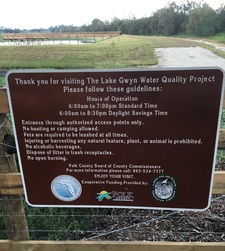 |
|
Polk County maintains a 99-year lease on the project site
from the Division
of State Lands, and the completed project is now open to
the public, complete with a pier that juts into the deep pool (indicated above by the
yellow arrow) at the south end of the site. There is even a walking path a little over a mile in length that encircles
the project. We hope you visit this beautifully restored site soon!
Total cost of the project was over $1.2 million with Florida's
State Wildlife Grants Program providing a $150,000 grant
through the Freshwater
Goal.
Left: The Lake Gwyn site is open for visitors, FWC Photo by Kevin Kemp.
|
Back to Top
Allie Perryman, State Wildlife Action Plan Coordinator
State Wildlife Action Plans across the country turned 10
years old in 2015, and for most states, this benchmark signified completion of the
first revision of their Action Plans. Plan
revisions are required every 10 years to remain eligible for State Wildlife
Grant funding. Florida, along with a handful of other states, chose to revise
every five years (or as needed) to ensure a flexible, living document that
could be updated as data gaps for species, habitats and mapping were filled;
tracking methods were developed and enhanced; new information arose; and
stakeholder and public input was received. Florida’s first
revised Action Plan was approved in 2012, so unlike in most
states, 2015 marked the beginning of our second revision.
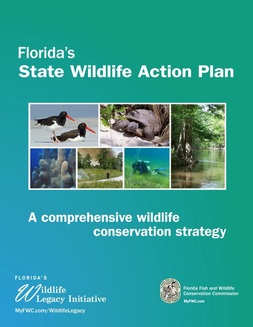
Right: Cover of the 2012 State Wildlife Action Plan.
During
the last 12 months, the Wildlife Legacy Initiative led difficult conversations
focused on what the next Action Plan should be, how it should function and
ultimately how it should be used. These
are not easy topics and the answers are not always clear, but the more input
and feedback we receive, the better we will be able to develop a plan that
meets the needs of the Florida Fish and Wildlife Conservation Commission and our partners.
From the efforts so far, it can be gleaned that this
revision will bring a more focused approach, narrowing in on the highest
priority conservation needs for Florida habitats and species. This approach
will help to create a user-friendly plan that can be successfully implemented,
and the impact of the plan’s implementation will be measurable. With 10 years
and one revision already under our belt, now is the time to show Florida’s
conservation successes over the years and set the bar high for the future.
The second revision is scheduled for completion in 2017,
and so we enter 2016 knowing there is a long way to go. We are confident,
however, in the direction we are taking on the Action Plan and as a program. This year will bring exciting new changes,
and we look forward to sharing them with you along the way.
For more information on the current Action Plan revision,
please contact Allie
Perryman.
|
Back to Top
Matthew Brady, Northeast Florida Ecosystem Restoration Team
Leader, Wildland Restoration International
Bob Bale, President, Wildland Restoration International
Florida contains large amounts of sandhill, scrub,
natural pineland and dry prairie habitats in both public and private ownership.
According to the 2012 State Wildlife
Action Plan (Action Plan), inappropriate fire regimes are
critical sources of stress to these habitats. Increasing the amount of both
ecologically appropriate fires and upland restoration activities is paramount
to long-term habitat health and species viability. Fire
leaders and land managers in Florida frequently cite the lack of full-time
dedicated “fire strike teams” with mobile equipment that can take advantage of
appropriate weather conditions, which is a common obstacle to increasing the
amount and frequency of acreage burned within critical upland habitats. The
need for landscape-scale, coordinated land management has long been
acknowledged, and support and development of prescribed fire strike teams is a
conservation action specifically called for in the Action Plan. Florida’s State Wildlife Grant Program,
through the Terrestrial Goal,
has supported or established five strike teams throughout the state.
The Northeast Florida Ecosystem Restoration Team (NEFL ERT) was part of
the Florida Chapter of The Nature Conservancy (Florida TNC)
from 2009 through 2014. Starting in 2015, the team began operating under Wildland Restoration International
(WRI), a non-profit fire management conservation organization. For the first six
months in 2015, WRI’s NEFL ERT continued to be funded by Florida TNC; the team
is now funded by a Florida State Wildlife Grant and Gopher Tortoise
Mitigation Funds through the FWC. The NEFL ERT is the only WRI crew in Florida, though
we hope to expand into other areas of the state.
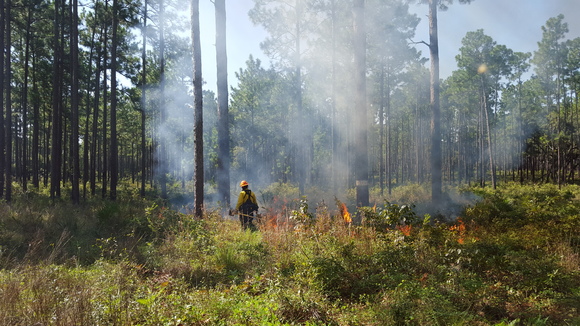 Ryan Kennelly, NEFL ERT’s Squad Leader, protects the red-cockaded
woodpecker tree (the tree with the white band around the trunk, foreground,
second from the right) on a burn in the Ocala National Forest, Photo courtesy of Wildland Restoration International.
There has been some exciting growth and development during the
team’s first year in Florida. Thus far, WRI has assisted in the burning of over
12,500 acres, treated almost 200 acres of exotic invasives and thinned nearly
100 acres of hardwood intrusion. There are now three full-time staff members
(as well as some per diem staff) based out of our Gainesville headquarters.
Additionally, WRI is excited to be bringing “fire-lighter” personnel from
partner organizations in the Northeast to detail with the NEFL ERT, giving
folks from outside the southern area a chance to learn about burning in Florida
as well as increasing crew capacity. The NEFL ERT operates with a Type 6
engine, a Polaris UTV outfitted for fire, and two ATVs equipped with a water
tank and ATV drip torch.
Back to Top
In
the Winter
2015 issue of the FWLI Newsletter, the Blue Ribbon Panel on Sustaining America's Diverse Fish and Wildlife Resources, established
by the Association of Fish and Wildlife
Agencies (AFWA), was highlighted. Over the past year, the Panel has met three
times to discuss a new 21st
century model of funding conservation that bridges the funding gap between game
and nongame species and secures a future for diverse fish and wildlife and the
economy. The Panel also hosted two listening sessions to hear from
conservation and business leaders about their ideas on sustainable fish and
wildlife conservation funding. The Panel’s recommendations will be unveiled at
the Teaming With Wildlife Fly-In event on March 2nd in Washington,
D.C. Although finished with their 1-year commitment, the Panelists are
dedicated to the implementation of their recommendations.
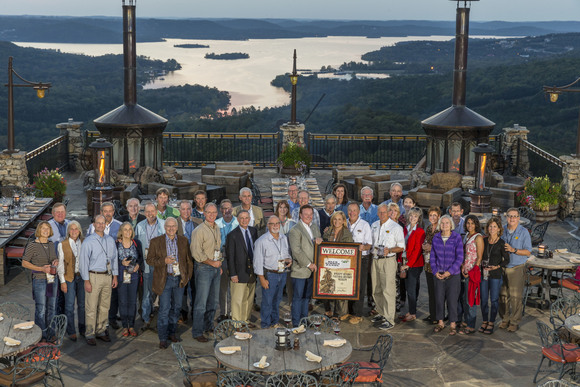 Blue Ribbon Panelists traveled to Big Cedar Lodge in Ridgedale, Missouri in September for their second meeting.
FWC provides assistance to the Panel: Back in August, AFWA reached
out to state fish and wildlife agencies for assistance with the Panel. The FWC,
along with five other state fish and wildlife agencies, agreed to temporarily
assign a wildlife biologist to AFWA’s efforts in Washington, DC. Each “state
detail” would shift his/her focus to the Blue Ribbon Panel for a maximum of 2
months each. The FWC re-assigned Wildlife Legacy Biologist Caroline Gorga to
AFWA, where she spent 7 weeks in Washington, D.C. assisting with meeting material
preparations, outreach and execution of the 2nd Panel meeting in
September 2015.
“The
experience was one of a kind,” said Caroline. “The Panelists are passionate
about fish and wildlife conservation and dedicated to the mission of the Blue
Ribbon Panel.”
“If
the Panel is successful, Florida could eventually receive a significant
increase in funding for conservation efforts identified in the State
Wildlife Action Plan,” said Brian Branciforte, Program Leader of Florida’s
Wildlife Legacy Initiative. “Currently, the FWC receives, on average, an annual
apportionment of $2.5 million from the State & Tribal Wildlife Grants Program to
implement the State Wildlife Action Plan, but this allocation, although
impactful, can only implement a fraction of what is called for in the Action Plan.”
Keep an eye out for the Summer 2016 Newsletter to learn about the Panel's recommendations!
Back to Top
The Association of Fish
and Wildlife Agencies
will host the annual Teaming With Wildlife Fly-In event on March 1st
and 2nd in Washington, D.C. The purpose of this event is to
demonstrate the wide-ranging support of the State & Tribal
Wildlife Grants Program and other wildlife
conservation legislation by conservation agencies, non-governmental
organizations and businesses around the nation to our elected officials. Florida’s State Wildlife
Grants Program
supports projects ranging from fire strike teams to coral reef and freshwater
restoration to filling species information and monitoring needs. From
wildlife biologists, hunters, anglers, birdwatchers and hikers to businesses
and organizations, the Teaming with Wildlife Coalition sends a strong message
to our elected officials that wildlife conservation is a critical issue and
needs additional, dedicated funding to keep species from becoming endangered.
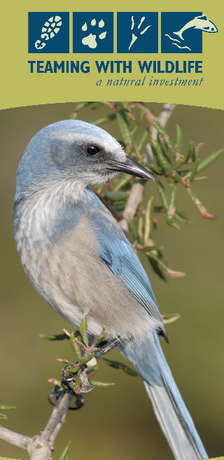 Over 50 individuals
from more than 20 states, including Florida Fish and Wildlife Conservation
Commission Executive Director, Nick Wiley, attended the 2015 Fly-In. This year’s event
will include the unveiling of the Blue Ribbon Panel's recommendations for
a new 21st century model of funding fish and wildlife conservation.
Florida’s Teaming
With Wildlife Coalition (TWW) currently numbers more than 270 members! In 2015, over 40 new members signed on to be a part
of the coalition. Among them are builders of custom fishing rods, metal
fabricators, construction companies, artists, clothiers, a battery company, an
eye clinic, bicycle shops and many other businesses and organizations that want
continued funding for wildlife conservation.
You
can join our efforts and those of the Blue Ribbon Panel to help secure
long-term dedicated funding for Florida wildlife conservation and related
education and recreation: Sign up and learn more about Florida’s
Team With Wildlife Coalition! Every participant
makes a difference!
|
Back to Top
Claire Sunquist Blunden, Imperiled Species Management Plan Coordinator
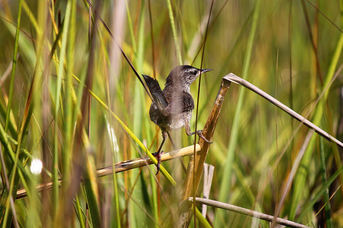 The
draft of Florida's Imperiled
Species Management Plan (ISMP), an innovative, integrated and comprehensive approach
to conserving multiple imperiled species, was presented at the Florida Fish and
Wildlife Conservation Commission (FWC) November meeting. The ISMP combines
managing the specific needs of 57 imperiled species with a new, larger-scale
strategy addressing how to help multiple fish and wildlife species thrive and
survive in the habitats they share. The plan was open for public comment
through January 20th and is scheduled to go before the Commission for final approval
in April 2016.
|
Above: Worthington's marsh wren. Research is currently underway in northeastern Florida to learn more about this species. The project received a State Wildlife Grant and addresses actions identified in the Species Action Plan, FWC Photo by Roxan Chicalo.
The ISMP and the State Wildlife Action Plan (Action Plan) are similar in that both plans include a list of species in need of research and management actions. All of Florida’s state threatened species are listed as Species of Greatest Conservation Need (SGCN) in the Action Plan. In addition to the 57 ISMP species, 979 other species, mostly invertebrates, are included on Florida’s SGCN list. The revised Action Plan will build off of the ISMP's actions and strategies, and work complementary by continuing a habitat-based approach to SGCN conservation.
The ISMP’s key objectives include working on filling data gaps and identifying more systematic, coordinated approaches to imperiled species management. The FWC designed the ISMP to make more efficient use of its resources in order to achieve measureable goals on important conservation priorities.
“This is an exciting and groundbreaking strategy with science working the way it should,” said Julie Wraithmell, Director of Conservation for Audubon Florida. “We are excited to see a tailor-made plan that will fit each species like a glove.”
Stakeholder involvement throughout this process has been very important to the FWC. “Working closely with stakeholders, we are blazing the trail with this innovative process,” said FWC Chairman Brian S. Yablonski. “Some species are going on the list and some are coming off but all 57 are winners in this process.”
The FWC first approved this new conservation model in 2010, and creating the plan has been a continuing collaborative effort. Recently, the public and stakeholders submitted more than 500 comments on improving earlier drafts of the plan. “Once the plan is approved in 2016, the FWC will need many partners, both individuals and organizations, to help make this plan a living, working approach to conserve these imperiled species for future generations,” said Dr. Brad Gruver, the Division of Habitat and Species Conservation section leader for Species Conservation Planning.
 When brown pelican chicks first hatch, they don’t look
anything like the adults, but in a few short months, they will be the same size
as their parents and have all of their feathers! FWC Photo.
Important
things to know about Florida's Imperiled Species Management Plan:
-
It includes one-page
summaries for each species, including a map of their range in Florida and
online links to their Species Action Plan. The action plans
contain specific conservation goals, objectives and actions for all 57
imperiled species.
- It also has
Integrated Conservation Strategies to benefit multiple species and their
habitats that focus implementation of the plan on areas and issues that yield
the greatest conservation benefit for the greatest number of species.
- The 57 species in the
plan include 8 mammals, 21 birds, 12 reptiles, 4 amphibians, 9 fish, and 3
invertebrates.
-
Among the plan’s 57
species, 14 were listed as state Threatened prior to the plan and will remain
listed as state Threatened; 23 will change listing from Species of Special
Concern to state Threatened; five will remain Species of Special Concern; and
15 (listed below) will be removed from the imperiled species list but continue
to be included in the plan for direction in monitoring and conserving them.
These fifteen species will remain on
the Species of Greatest Conservation Need List: Eastern
chipmunk, Florida
mouse, brown
pelican, limpkin, snowy
egret, white
ibis, peninsula
ribbon snake (Lower Keys population), red
rat snake (Lower Keys population), striped
mud turtle (Lower Keys population), Suwanee
cooter, gopher
frog, Pine
Barrens treefrog, Lake
Eustis pupfish, mangrove
rivulus,
and the Florida
tree snail
Find out more about
the Imperiled Species Management Plan at MyFWC.com/Imperiled.
Peninsula
ribbon snake. This is the only striped snake in the Keys! FWC Photo by Kevin Enge.
Back to Top
We don’t
always take enough time to celebrate hard work and amazing accomplishments.
Florida’s Wildlife Legacy Initiative would like to recognize the following principal investigators who finished their State Wildlife Grant-funded projects in the past six months. The projects below demonstrate the wide
variety of conservation efforts taking place in Florida – research, on-the-ground restoration and management, mapping and monitoring. For
more information on the following projects, please contact Andrea.Alden@MyFWC.com or Robyn.McDole@MyFWC.com.
Congratulations to all on work well done!
1. Conservation of Florida's Fox Squirrels - Robert McCleery, University of Florida
Funded through the Data Gaps Goal, the goal of this project was to address data gaps related to the distribution, genetic differentiation and response to habitat management actions of Florida’s three fox squirrel species: Big Cypress fox squirrel (state Threatened species), Sherman’s fox squirrel (Species of Special Concern), and Southeastern fox squirrel. This project developed a new statewide fox squirrel monitoring protocol that uses remote cameras to identify individual fox squirrels as an alternative to labor-intensive live-trapping efforts. (View the abstract)
Sherman's fox squirrel, FWC Photo by Patrick Delaney.
2. Multi-Species of Greatest Conservation Need: Fish Population, Presence and Location Validation - Micheal Allen, University of Florida
Funded through the Data
Gaps Goal, the goal of this project was to address data gaps for the
black-banded sunfish and the bluenose
shiner, a state Threatened species, by estimating the detection probability
and habitat occupancy of both Species of Greatest
Conservation Need (SGCN). Habitat
occupancy modeling is a promising conservation tool which uses presence-absence
data and can be used to overcome some of the limitations inherent in the
sampling of cryptic and/or rare species.
3. Shorebird Research and Management at Florida Panhandle State Parks - Raya Pruner, Florida Department of Environmental Protection, Florida Park Service, District 1
Funded through the Data Gaps Goal, the goal of this
project was to increase productivity and ultimately the size of Florida’s
breeding population through an increase in shorebird monitoring and management
at Florida State Parks and to increase the
quality of beach habitat. The project addressed the following three threats to
the protection of shorebirds and their habitat: human-related disturbance,
nuisance and non-native predators and inadequate management of public lands. (View the abstract)
An adult least tern in flight, FWC Photo by Carol Rizkalla.
4. Development of a Seagrass Monitoring Program for the Springs Coast - Paul Carlson, FWC
Funded through the 2006-2011 Habitat
Conservation Goal,
the goal of this project was to establish a seagrass monitoring program for the
Springs Coast, which is the third largest contiguous seagrass bed in Florida.
Seagrass provides vital habitat for many economically important fish and
shellfish species as well as many SGCN.
The Springs Coast seagrass was last monitored in 2007 (5 years prior to this
project). In order to appropriately manage and protect this important resource,
researchers must routinely monitor the health, status and trend of seagrass
beds and identify potential impacts before the seagrass is affected. This
project found the Springs Coast seagrass to be in generally good shape, but
identified potential impacts that could affect the habitat in the future
without management actions, such as prop scaring (especially in the Homosassa
region) and anthropogenic nutrient loading from nearby coastal development. (View the abstract or explore FWC's Fish and Wildlife Research Institute Seagrasses Web page)
5. Seagrass Monitoring in Florida Panhandle Estuaries - Laura Yarbro, FWC
Funded
through the Species & Habitat
Monitoring Objective,
the goal of this project was to fill monitoring gaps identified for seagrass
ecosystems in the Pensacola Bay system, St. Andrew Bay, Choctawhatchee Bay and
St. Joseph Bay in the Florida Panhandle, where routine monitoring is lacking
and where tropical storms and heavy rains in 2012 and 2013 negatively impacted
the seagrasses. St. Andrew Bay and St. Joseph Bay were of special interest due
to the important scallop habitat provided by the seagrass in both bays. Data
gathered during this effort was compared to that taken in 2010 and 2011, and
results will be used to update the information in the Seagrass Integrated
Mapping and Monitoring Report. (View the abstract)
6. Investigation of a Previously Undescribed Octocoral Disease Affecting the Florida Reef Tract - Vanessa Brinkhuis, FWC
Funded
through the Marine Goal, the goal of this
project was to investigate and characterize a presently undescribed octocoral
disease observed on coral reef habitats off southeast Florida, the Florida Keys
National Marine Sanctuary and the Dry Tortugas National Park. From field observations
of octocoral colonies infected with the disease, the colonies progressively turn a black or purple color (see picture below), and normal colony functions decreased as the
color changed. Data obtained from this project are necessary to determine the
locations of healthy communities to provide potential transplants and to
determine where to focus restoration efforts to ensure that restoration of
these octocoral-dominated communities be successful. (View the abstract or explore FWC's Fish and Wildlife Research Institute Coral Reef Web page)
Healthy Eunicea tourneforti, a species of octocoral, FWC Photo by Vanessa Brinkhuis.
Eunicea tourneforti infected by the previously undescribed disease. Colonies that are infected progressively turn a black or purple color. Compare this photo to the photo of above of healthy coral, FWC Photo by Vanessa Brinkhuis.
7. Genetic Differentiation among Florida Populations of Diadema antillarum - Eric Hoffman, University of Central Florida
Funded through the Marine Goal, this project used
molecular genetic markers (microsatellites) to determine the extent of genetic
diversity among populations of the long-spined, black sea urchin Diadema antillarum in Biscayne Bay, the
Florida Keys and Dry Tortugas. This
information is essential for promoting conservation of this species after a
disease-induced bottleneck killed approximately 90% of individuals in the
1980s, as well as forwarding Mote Marine Laboratory’s
and the FWC’s efforts for D.
antillarum captive-breeding and release. This sea urchin’s role on coral
reefs is to consume macroalgae, which can negatively impact the survival of
coral reefs if allowed to flourish. (View the abstract)
8. Lake Gwyn Wetland Re-Hydration - Robert Kollinger, Polk County Parks and Natural Resources Division
See
the article, “Lake Gwyn Wetland
Re-Hydration Project Completed & Open to the Public!” in this issue of
the FWLI Newsletter for more information. (View the abstract)
Back to Top
|